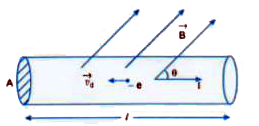InterviewSolution
Saved Bookmarks
| 1. |
Derive an expression for the force acting on a current carrying conductor placed in a uniform magnetic field. Name the rule which gives the direction of the force. Write the condition for which this force will have (i) maximum (ii) minimum value. |
|
Answer» Solution :Consider a current conductor of length l and cross-section area A. If n be the free electron density for the metal of conductor then TOTAL number of free electrons in n A l. For a steady current I in the conductor, let each free electron has an average drift `vecv_d` velocity in the presence of a MAGNETIC field `vecB` HENCE, Lorentz magnetic force on a mobile electron is `VECF = -e (vecv_d xx vecB)` `:.` Force on all the mobile/free electrons of the conductor `vecF = vecf cdot n A l = - n A l e (vecv_d xx vecB)` `= I (vecl xx vecB) "" [ :. I = - n A e vecv_d]` Direction of the force is given by Fleming.s left hand rule. If magnetic field `vecB` makes an angle `theta` from the conductor then magnitude wise `F = I l B sin theta` (i) The force will have a maximum value `F_("max") = I l B` when `theta = 90^@ and sin theta = 1` (II) The force will have a zero value, when `theta= 0^@` or `180^@` and `sin theta = 0`. 
|
|